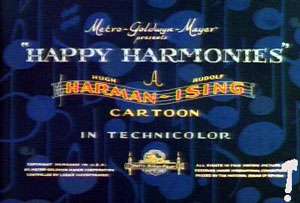Happy Harmonies

Happy Harmonies is a series of animated cartoons distributed by Metro Goldwyn Mayer and produced by former Disney and Warner Bros employees Hugh Harman and Rudolf Ising between 1934 and 1938.
Produced in Technicolor (although the first two were in Cinecolor), these cartoons were the duos answer to Walt Disney's Silly Symphonies. They would occasionally feature their star character Bosko, a character who starred in the first Looney Tunes shorts that the duo produced for Leon Schlesinger. After the first few releases, the design of Bosko changed from an ink blot to a realistic African American boy. 36 cartoons were made in this series.
Harman And Ising would also make many oneshot cartoons for MGM after this series folded, which were still in a similar vein to this series, such as Peace on Earth. A couple of Happy Harmonies shorts (Good Little Monkeys and Little Cheeser) spawned sequels even after the series was discontinued.
1934
- The Discontented Canary (1934)
- The Old Pioneer (1934)
- Tales of the Vienna Woods (1934)
- Bosko's Parlor Pranks (1934)
- Toyland Broadcast (1934)
1935
- Hey-Hey Fever (1935)
- When the Cat's Away (1935)
- The Lost Chick (1935)
- The Calico Dragon (1935)
- Good Little Monkeys (1935)
- The Chinese Nightengale (1935)
- Poor Little Me (1935)
- Barnyard Babies (1935)
- The Old Plantation (1935)
- Honeyland (1935)
- Alias St. Nick (1935)
- Run, Sheep, Run (1935)
1936
- Bottles (1936)
- The Early Bird and the Worm (1936)
- The Old Mill Pond (1936)
- Two Little Pups (1936)
- The Old House (1936)
- The Pups' Picnic (1936)
- To Spring (1936): Notable for being the directorial debut of William Hanna.
- Little Cheeser (1936)
- The Pups' Christmas (1936)
1937
- Circus Daze (1937)
- Swing Wedding AKA Hot Frogs (1937)
- Bosko's Easter Eggs (1937)
- Little Ol' Bosko and the Pirates (1937)
- The Hound And The Rabbit (1937)
- The Wayward Pups (1937)
- Little Ol' Bosko and the Cannibal (1937)
1938
- Little Ol' Bosko in Bagdad (1938)
- Pipe Dreams (1938)
- The Little Bantamweight (1938)
- Affectionate Parody: Tex Avery would later lampoon "Poor Little Me" with his MGM cartoon "Little 'Tinker".
- All Just a Dream: The ending of "Bottles".
- Animation Bump: Later entries in the series.
- Art Evolution: Like Disney, the early cartoons were basically just more polished versions of their Warner Bros. cartoons, but art studies and research allowed their cartoons to get fairly close to what Disney was doing.
- Cats Are Mean: "The Discontented Canary", "When The Cat's Away", "Poor Little Me", "Little Cheeser"
- Everythings Nuttier With Squirrels: "The Lost Chick"
- Follow the Leader: Of course! The only studio that didn't try to imitate Disney's Silly Symphonies was the Terry Toons studio, after all.
- Good Angel, Bad Angel: "Little Cheeser"
- Living Toys: "Toyland Broadcast"
- Mouse World: "When the Cat's Away", "Little Cheeser"
- Painting the Frost on Windows: The dwarves in "To Spring".
- Precious Puppies: The shorts starring the Two Little Pups.
- Public Domain Animation: The short "To Spring".
- Ridiculously Cute Critter: Most shorts.
- Smelly Skunk: In "Poor Little Me".
- Spring Is Late: "To Spring"
- Stock Footage: "Bosko's Parlor Pranks" is basically nothing but recycled animation from the earlier Bosko cartoons, done by Harman And Ising in order to fulfill their yearly quota of shorts.
- When It Rains, It Pours: In the later part of "The Discontented Canary".
- Woodland Creatures: Starred in quite a few shorts.